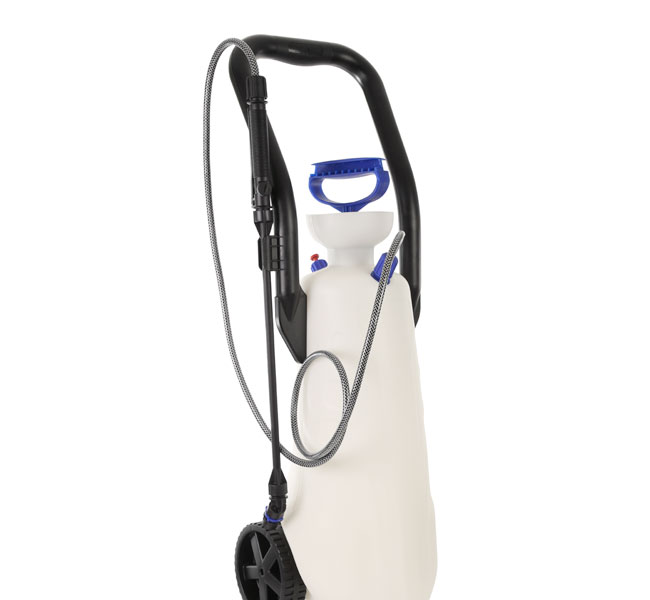
Frequently Asked Questions:
General
Chemical products often comprise of many different chemicals which can effect the component materials of the sprayer/dispenser (e.g. swelling or corrosion). The concentration of these chemicals and the temperature can give different results. Time is another factor – a component may not show any reaction used many times in a short period but can show a reaction when used a few times over a long period. How long do you need the sprayer/dispenser to last? 1 day? 1 week? 6 months? We can therefore, only advise as to whether our products are suitable for use with general chemical components and recommend you carry out trials to ensure compatibility with your own formulation.
Ask your supplier if they can provide a Safety Data Sheet. It should show a list of the main chemical components with the concentrations expressed as a percentage. This will help us to give you advice.
Hand Sprayers
Hydrocarbon Solvents will make plastics swell – because they are both derived from crude oil and have, in part, the same molecules. Standard sprayers will have plastic pumps but our solvent sprayers have stainless steel or polyamide (a type of nylon) pumps which are suitable with these solvents.
Pressure Sprayers
This depends on what chemicals you are spraying. Flourocarbon (trade name Viton) is the best overall resistant material to the widest range of chemicals. However, it is more expensive than other materials and may not be necessary. Nitrile (or Buna N) is lower in cost and is suitable for many water based chemicals. Ask our staff for more information about your chemicals.
Actual capacity is the ‘total’ capacity of the container. However, the pressure sprayer needs an amount of air to compress, to force the chemical out. The working capacity is the maximum amount of product which can be filled to operate the sprayer.
To get the best results from your sprayers we recommend they are completely emptied and rinsed through after each use.
Taps
When dispensing through a tap, the container needs to be ‘vented’ – air needs to get into the container – otherwise a vacuum will be created and the product will ‘glug’ out or be difficult to dispense. Often with the larger containers, there are two bungs opposite each other and when a tap is fitted to the one, the other can be opened to let the air in. With smaller containers or those with only one opening, you will need a self-venting tap. This lets air in at the same time as dispensing the chemical.
Trigger Sprayers
The standard Trigger Sprayers have a 28mm diameter cap with two different heights – Deep (28/410) and Shallow or Short (28/400). In the UK, the most common size for the retail market or Ready to Use (RTU) pack is the 28/410. The industrial/re-useable packs tend to have the 28/400 caps. These references correspond to the necks on the bottle so your bottle manufacturer can confirm what neck is on their bottle.
Trigger sprayers are notorious for ‘backing-off’. The vibration of being ‘in transit’, loosens the cap and leakage can occur. The answer is to have a suitable neck on the bottle – one that suits the trigger cap and if possible, has an anti-back off system in the thread. An anti-back off system has extra pieces in the thread – either a twin thread, vertical pieces or a series of ‘lugs’ around the neck that gives resistance to the cap vibrating loose.
For easy priming of long tube sprayers, hold the sprayer at the same level of the liquid until it is primed.
Dispenser Pumps
Generally speaking, the more viscous (thick) the product, the larger the diameter of the suction pipe needs to be in order to minimise the effort required to draw it into the chamber of the pump. A wider suction pipe will not draw liquid up quicker – with less viscous (thin) products, a thinner suction pipe is better.
Drum Fittings/Threads
Steel containers generally have a 3/4″ and/or 2″BSP (British Standard Pipe) or fine thread. It is very difficult to produce plastic containers with such a fine thread and so they have more coarse threads. The two most common plastic threads are a 56 x 4 Buttress Thread and the more coarser 70 x 6 Buttress Thread. Most drum pumps will have a ‘standard’ 2” BSP thread and so we supply Drum Adapters to suit both of the Buttress threads above. Containers can have Internal (Female) threads (as above) or External (Male) threads which are sealed with a cap. You can still use a drum pump on these threads with our External Thread Adapter (see Drum Pumps & Adapters).
get in touch by email or phone 01926 482841


